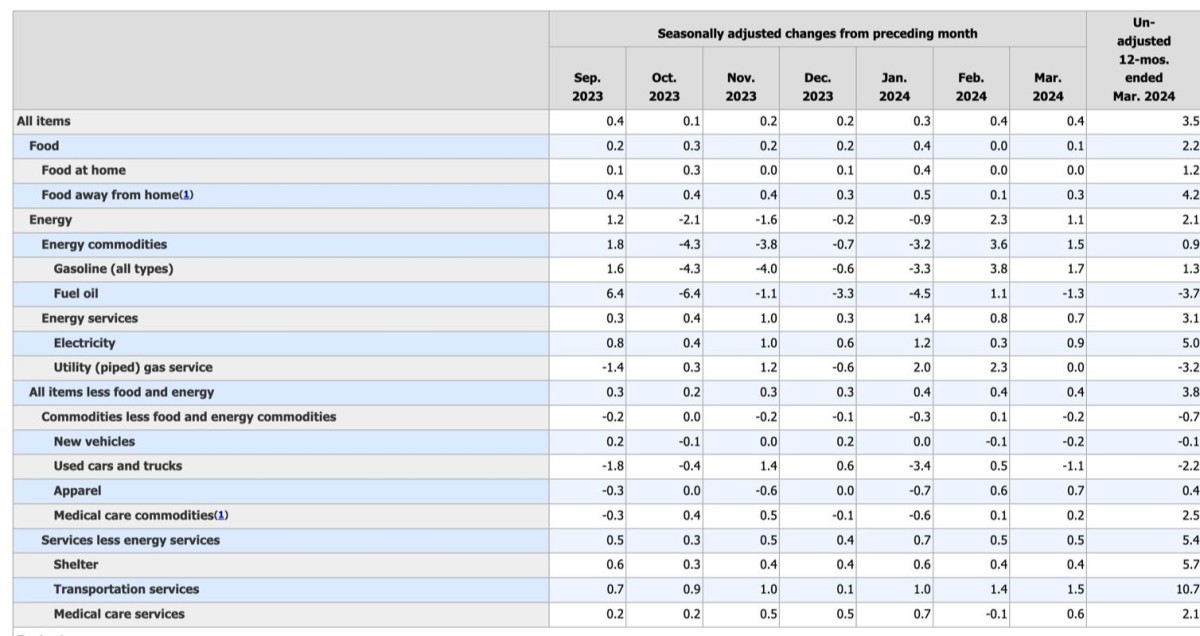Three months into 2024, and we’re already grasping at straws trying to understand the trajectory of U.S. inflation. Despite a slowdown from the fiery rates of 2022, the decline isn’t as swift or as steady as anyone hoped. Inflation is hanging around like a bad odor, and the expectations for its future course are only climbing.
While consumers scratch their heads at rising prices at checkouts, and producers wince at escalating wholesale costs, a general unease pervades from Wall Street to Main Street. The confusion isn’t just among the masses. Even the sharpest economic minds didn’t see this persistence coming.
Stocks are feeling the pinch too, with the Dow Jones Industrial Average taking a nosedive, shedding nearly 500 points and wiping out most of its yearly gains—all in a week’s work.
Investors once cheered for an accommodating Federal Reserve, which teased with interest rate cuts aplenty early in the year. However, every fresh batch of stubborn inflation data has them revising their bets, now barely hoping for a couple of cuts. The futures market holds a bleak view with a 9% chance that we might not see any rate reductions this year.
Reassessing Expectations Amid Rising Costs
As if the domestic drama wasn’t enough, global events are tossing more fuel on the inflationary fire. A report hinted at the current Iran and Israel conflict, which only propelled energy prices upwards.
It’s clear that external shocks are still in play, complicating the Fed’s strategy and the market’s response. This week alone has been a rollercoaster. Starting with a jolt from the New York Fed’s consumer survey, which revealed a sharp uptick in expected rent increases, to a dismal business sentiment report from the National Federation of Independent Business.
Then came the consumer and wholesale price reports, each surpassing gloomy expectations. Import prices, usually a background figure in economic analyses, have made headlines with significant jumps, marking the largest three-month increase in nearly two years.
The Federal Reserve, for their part, are monitoring these developments but aren’t sounding the alarm just yet. They remain hopeful of achieving a balanced economy and meeting their 2% inflation target, but the convergence of their dual mandate goals appears more like a distant dream.
Persistent Challenges and Market Reactions
Despite the focus on consumer and producer price indexes, the Fed typically keeps an eye on the personal consumption expenditures price index, which offers a slightly different perspective by accounting for changes in consumer behavior and less weighting on housing costs.
February’s PCE readings indicated a core inflation rate slightly above the Fed’s comfort zone, and we’re anxiously awaiting the March figures.
Meanwhile, economic indicators like the sticky price CPI and the Dallas Fed’s trimmed mean PCE suggest inflation is digging in its heels. The sticky price CPI, which includes long-term goods like housing and medical services, ticked up to 4.5%. Meanwhile, the flexible CPI, which shows more volatile prices like food and energy, showed a sharp increase.

What’s interesting is the dichotomy in the economic atmosphere.
On one hand, the economy is strong enough to handle high rates, showing little distress in employment or macroeconomic growth. Yet, the labor market is starting to show signs of strain, and cracks might just widen if these conditions persist.
For Americans hoarding cash, the recent inflation report is a mixed bag. Sure, consumer prices are climbing faster than expected, but this also means the Fed might delay any rate cuts, keeping yields on money market funds and Treasury bills attractively high. Money fund yields are holding strong, and the influx of cash into these funds speaks volumes about where investor confidence currently lies.
All told, it’s clear that the Fed and the rest of us are still trying to get a handle on inflation’s stubborn streak. With each new data point, hopes for quick fixes are dashed, leaving us worried about US’s economy or actively praying on its downfall.
Whichever side you’re on, cheers!
Land a High-Paying Web3 Job in 90 Days: The Ultimate Roadmap
